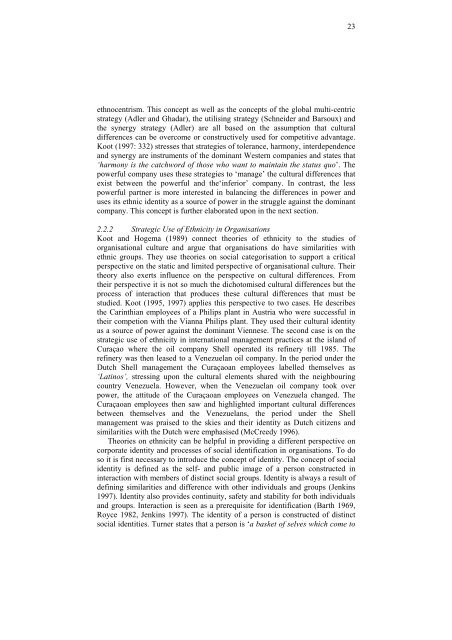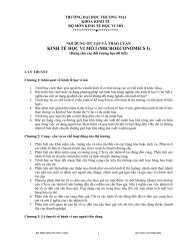The Internationalisation of PTT Telecom: A Cultural Perspective - Free
The Internationalisation of PTT Telecom: A Cultural Perspective - Free
The Internationalisation of PTT Telecom: A Cultural Perspective - Free
- No tags were found...
Create successful ePaper yourself
Turn your PDF publications into a flip-book with our unique Google optimized e-Paper software.
23ethnocentrism. This concept as well as the concepts <strong>of</strong> the global multi-centricstrategy (Adler and Ghadar), the utilising strategy (Schneider and Barsoux) andthe synergy strategy (Adler) are all based on the assumption that culturaldifferences can be overcome or constructively used for competitive advantage.Koot (1997: 332) stresses that strategies <strong>of</strong> tolerance, harmony, interdependenceand synergy are instruments <strong>of</strong> the dominant Western companies and states that‘harmony is the catchword <strong>of</strong> those who want to maintain the status quo’. <strong>The</strong>powerful company uses these strategies to ‘manage’ the cultural differences thatexist between the powerful and the‘inferior’ company. In contrast, the lesspowerful partner is more interested in balancing the differences in power anduses its ethnic identity as a source <strong>of</strong> power in the struggle against the dominantcompany. This concept is further elaborated upon in the next section.2.2.2 Strategic Use <strong>of</strong> Ethnicity in OrganisationsKoot and Hogema (1989) connect theories <strong>of</strong> ethnicity to the studies <strong>of</strong>organisational culture and argue that organisations do have similarities withethnic groups. <strong>The</strong>y use theories on social categorisation to support a criticalperspective on the static and limited perspective <strong>of</strong> organisational culture. <strong>The</strong>irtheory also exerts influence on the perspective on cultural differences. Fromtheir perspective it is not so much the dichotomised cultural differences but theprocess <strong>of</strong> interaction that produces these cultural differences that must bestudied. Koot (1995, 1997) applies this perspective to two cases. He describesthe Carinthian employees <strong>of</strong> a Philips plant in Austria who were successful intheir competion with the Vianna Philips plant. <strong>The</strong>y used their cultural identityas a source <strong>of</strong> power against the dominant Viennese. <strong>The</strong> second case is on thestrategic use <strong>of</strong> ethnicity in international management practices at the island <strong>of</strong>Curaçao where the oil company Shell operated its refinery till 1985. <strong>The</strong>refinery was then leased to a Venezuelan oil company. In the period under theDutch Shell management the Curaçaoan employees labelled themselves as‘Latinos’, stressing upon the cultural elements shared with the neighbouringcountry Venezuela. However, when the Venezuelan oil company took overpower, the attitude <strong>of</strong> the Curaçaoan employees on Venezuela changed. <strong>The</strong>Curaçaoan employees then saw and highlighted important cultural differencesbetween themselves and the Venezuelans, the period under the Shellmanagement was praised to the skies and their identity as Dutch citizens andsimilarities with the Dutch were emphasised (McCreedy 1996).<strong>The</strong>ories on ethnicity can be helpful in providing a different perspective oncorporate identity and processes <strong>of</strong> social identification in organisations. To doso it is first necessary to introduce the concept <strong>of</strong> identity. <strong>The</strong> concept <strong>of</strong> socialidentity is defined as the self- and public image <strong>of</strong> a person constructed ininteraction with members <strong>of</strong> distinct social groups. Identity is always a result <strong>of</strong>defining similarities and difference with other individuals and groups (Jenkins1997). Identity also provides continuity, safety and stability for both individualsand groups. Interaction is seen as a prerequisite for identification (Barth 1969,Royce 1982, Jenkins 1997). <strong>The</strong> identity <strong>of</strong> a person is constructed <strong>of</strong> distinctsocial identities. Turner states that a person is ‘a basket <strong>of</strong> selves which come to




